Physical Address
304 North Cardinal St.
Dorchester Center, MA 02124
Benign peripheral nerve sheath tumors differ from other soft tissue tumors in several important respects. Most soft tissue tumors arise from mesodermally derived tissue and display a range of features consonant with that lineage. Nerve sheath tumors arise from tissues considered to be of neuroectodermal or neural crest origin and display a range of features that mirrors the various elements of the nerve (e.g., Schwann cell, perineurial cell). Whereas most soft tissue tumors only seem to be encapsulated by virtue of the compression of surrounding tissues against their advancing border, benign nerve sheath tumors arising in a nerve are completely surrounded by epineurium or perineurium and therefore have a true capsule , a feature that facilitates their enucleation. Finally, benign nerve sheath tumors represent the most important group of benign soft tissue lesions in which malignant transformation is an acknowledged phenomenon. Sarcomas develop in neurofibromas in a subset of patients with neurofibromatosis 1, thereby providing an excellent model in which to study the molecular pathway of malignant transformation.
This chapter discusses the two principal benign nerve sheath tumors, schwannoma and neurofibroma, their associated syndromes, and the more recently recognized perineurioma. Schwannomas recapitulate in a more or less consistent fashion the appearance of the differentiated Schwann cell, whereas neurofibromas display a spectrum of cell types ranging from the Schwann cell to the fibroblast. Schwannomas and neurofibromas are distinctive lesions that can be reproducibly distinguished from one another, in most instances, by their pattern of growth, cellular composition, associated syndromes, and cytogenetic alterations ( Table 26.1 ). Perineuriomas mirror the barrier (perineurial) cell of the nerve sheath, as recognized by certain characteristic ultrastructural and immunophenotypic features.
| Schwannoma | Neurofibroma | |
|---|---|---|
| Age | 20-50 yr | 20-40 yr; younger in NF1 |
| Common locations | Head and neck; flexor portion of extremities; less often retroperitoneum and mediastinum | Cutaneous nerves; deep locations in NF1 |
| Encapsulation | Usually | Usually not |
| Growth patterns | Encapsulated tumor with Antoni A and B areas; plexiform type uncommon | Localized, diffuse, and plexiform patterns |
| Associated syndromes | Most lesions sporadic; some NF2 and schwannomatosis, rarely NF1 | Most lesions sporadic; some NF1 |
| S-100 protein and SOX10 immunostain | Strong and uniform | Variable staining of cells |
| Malignant transformation | Exceptionally rare | Rare in sporadic cases but occurs in 2%–3% of NF1 patients |
The peripheral nervous system consists of nervous tissue outside the brain and spinal cord and includes somatic and autonomic nerves, end-organ receptors, and supporting structures. It develops when axons lying close to one another grow out from the neural tube and are gradually invested with Schwann cells. Schwann cells arise from the neural crest, a group of cells that arise from and lie lateral to the neural tube and underneath the ectoderm of the developing embryo. The major peripheral nerve trunks form by fusion and division of segmental spinal nerves and contain mixtures of sensory, motor, and autonomic elements.
In the fully developed nerve, a layer of connective tissue or epineurium surrounds the entire nerve trunk ( Fig. 26.1 ). This structure varies in size, depending on the location of the nerve, and is composed of a mixture of collagen and elastic fibers along with mast cells. Several nerve fascicles lie within the confines of the epineurium, and each in turn is surrounded by a well-defined sheath known as the perineurium . The outer portion of the perineurium consists of layers of connective tissue, and the inner portion is represented by a multilayered, concentrically arranged sheath of flattened cells. The perineurium, which is continuous with the pia-arachnoid of the central nervous system, represents the principal diffusion barrier for the peripheral nerve. Unlike the Schwann cell, the perineurial cell is a mesodermal derivative sharing an immunophenotype with the cells of the pia-arachnoid (S-100 protein negative; epithelial membrane antigen [EMA], GLUT1, and claudin-1 positive). Ultrastructurally, perineurial cells form close junctions with each other and have basal lamina along the endoneurial and perineurial aspects of the cell, features not encountered in the ordinary fibroblast and Schwann cell.

Despite the undoubted importance of the investing connective tissue, the critical supporting element is the Schwann cell . It provides mechanical protection for the axon, produces and maintains the myelin sheath, and serves as a tube to guide regenerating nerve fibers. Ultrastructurally, the Schwann cell is easily identified by its intimate relation to its axons and by a continuous basal lamina that coats the surface of the cell facing the endoneurium. In routine preparations, it is difficult to distinguish the axon from the myelin sheath. This distinction, however, is easily accomplished with special stains. Silver stains selectively stain the axon ( Fig. 26.2 ), whereas stains such as Luxol fast blue stain myelin. The variation in diameter of the axon and myelin sheath can be appreciated with these stains. In general, moderately or heavily myelinated fibers correspond to sensory and motor fibers with fast conduction speeds, whereas lightly myelinated or unmyelinated fibers correspond to autonomic fibers with slower conduction speeds. Ultrastructurally, the cytoplasm of the axon is characterized by numerous cytoplasmic filaments, slender mitochondria, and a longitudinally oriented endoplasmic reticulum. Nissl substance, a feature of the nerve cell body, is not present in the axoplasm. In addition, small vesicles are observed occasionally; they may represent packets of neurotransmitter substance en route to the nerve terminal.
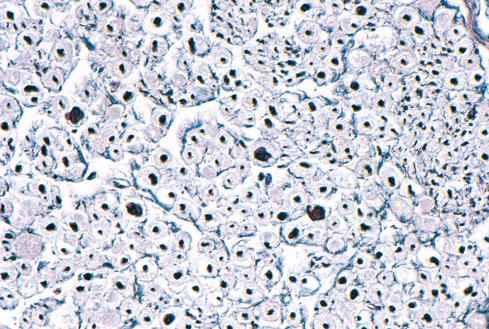
Traumatic neuroma is an exuberant, but nonneoplastic, proliferation of a nerve occurring in response to injury or surgery. Under ideal circumstances, the ends of a severed nerve reestablish continuity by an orderly growth of axons from proximal to distal stump through tubes of proliferating Schwann cells. However, if close apposition of the ends of a nerve is not maintained, or if there is no distal stump, a disorganized proliferation of the proximal nerve gives rise to a neuroma. Symptomatic neuromas are usually the result of surgery, notably amputation. Occasionally, other surgical procedures, such as cholecystectomy, have been implicated in their pathogenesis. A rare form of traumatic neuroma is seen in rudimentary (supernumerary) digits that undergo autoamputation in utero. These lesions appear as raised nodules on the ulnar surface of the proximal fifth finger and contain a disordered proliferation of nerves similar to a conventional traumatic neuroma ( Fig. 26.3 ).
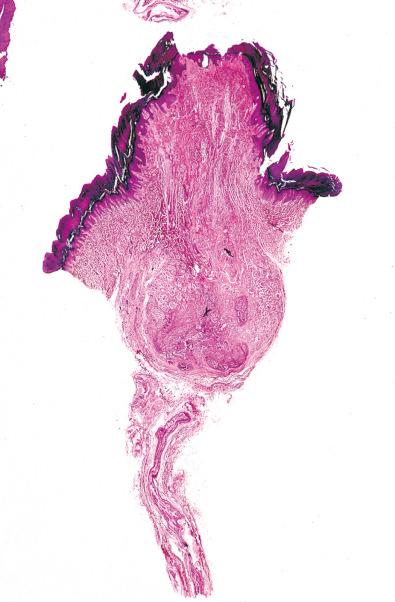
Clinically, the neuroma presents as a firm nodule that is occasionally tender or painful. Strangulation of the proliferating nerve by scar tissue, local trauma, and infection may explain the pain. Grossly, the lesions are circumscribed, white-gray nodules seldom exceeding 5 cm in diameter; they are located in continuity with the proximal end of the injured or transected nerve. They consist of a haphazard proliferation of nerve fascicles, including axons with their investitures of myelin, Schwann cells, and fibroblasts. The fascicles are usually less well myelinated than the parent nerve and are embedded in a background of collagen ( Fig. 26.4 ).
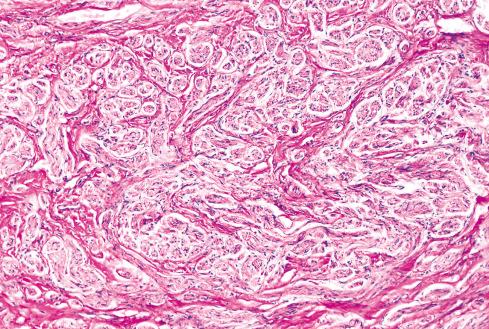
Traumatic neuromas are sometimes confused with solitary circumscribed neuromas (palisaded encapsulated neuromas) and neurofibromas. Participation of all elements of the nerve fascicles and identification of a damaged nerve distinguish a traumatic neuroma from neurofibroma . In areas where the fascicles are small and the matrix is poorly collagenized and highly myxoid, the similarity to neurofibroma may be striking ( Fig. 26.5 ) and therefore may require identification of subtler clues, such as the characteristic collagen bundles of neurofibroma. Solitary circumscribed neuromas arise exclusively in the skin, predominantly in women; they consist of a more circumscribed, orderly arrangement of nerve fascicles.
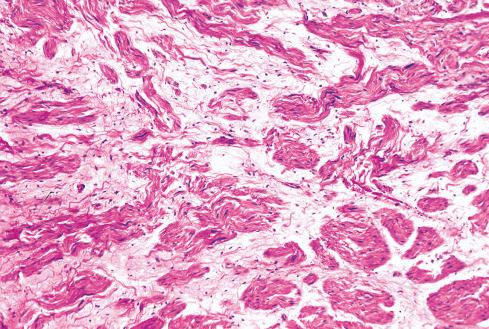
Treatment of traumatic neuromas is partly prophylactic. After traumatic nerve injury, an attempt should be made to reappose the ends of the severed nerve so that regeneration of the proximal end proceeds down the distal trunk in an orderly manner. Once a neuroma has formed, removal is indicated when it becomes symptomatic or when it must be distinguished from recurrent tumor in a patient who has had cancer-related surgery. Simple excision of the lesion and reembedding the proximal nerve stump in an area away from the old scar constitute the conventional therapy.
Germline-activating mutations of the RET proto-oncogene are responsible for several familial syndromes, including multiple endocrine neoplasia (MEN) 2b (or IIB) (thyroid carcinoma, pheochromocytoma, and mucosal neuromas). Patients with this disease develop characteristic neuromas of the mucosal surfaces of the lips, mouth, eyelids, and intestines. Because mucosal neuromas may represent an early manifestation of this life-threatening syndrome, recognition of these lesions is of more than academic interest. The lesions manifest during the first few decades of life and present as multiple nodules of varying size, which may result in diffuse enlargement of the affected area.
Focally, the lesions are notable for the irregular, tortuous bundles of nerve with a prominent perineurium that lie scattered throughout the submucosa of the oral cavity ( Fig. 26.6 ). The nerves and perineurium may be distinguished by a prominent degree of myxoid change. In the gastrointestinal (GI) tract, both submucosal and myenteric plexus appear hyperplastic, with an increase in all elements of the plexus, including Schwann cells, neurons, and ganglion cells ( Fig. 26.7 ).
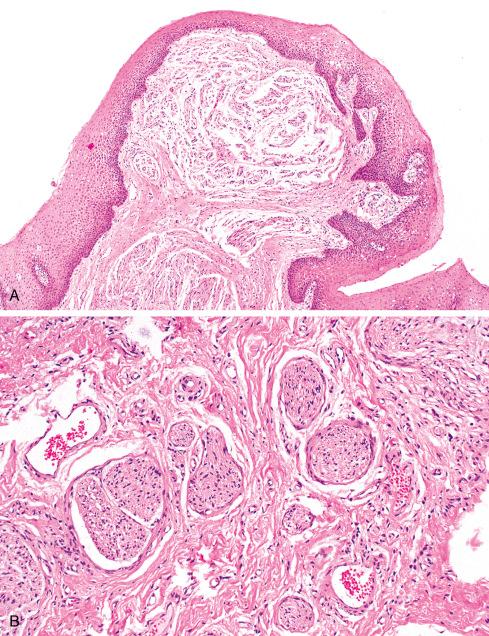
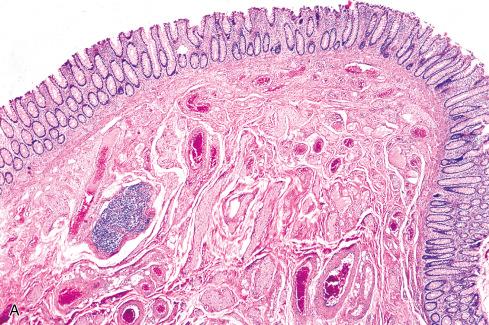
Pacinian neuroma refers to localized hyperplasia or hypertrophy of the pacinian corpuscles, which occurs after trauma and usually produces pain. Typically, it develops on the digits, where it produces a localized mass. Pacinian neuromas range in appearance from small nodules attached to the nerve by a slender stalk to one or more contiguous subepineural nodules ( Fig. 26.8 ). Histologically, it consists of mature pacinian corpuscles that are increased in size or number (or both) and are often associated with degenerative changes and fibrosis of the adjacent nerve. The principal problem in the differential diagnosis is the distinction of these lesions from a normal pacinian body, which can achieve a size sufficient to be visualized macroscopically. For example, normal pacinian bodies can be identified in the abdominal cavity, where they are occasionally misinterpreted as tumor implants. We have also seen pacinian bodies in the stomach, an unexpected location where they are easily mistaken for a neural tumor. In pacinian neuromas the structures usually are larger than 1.5 mm in diameter. In general, a pacinian neuroma is diagnosed when the histologic features described previously are associated with a discrete pain-producing mass. Pacinian neuromas should not be confused with “pacinian neurofibromas,” a term loosely used to describe a heterogeneous group of lesions that probably includes neurofibroma, congenital nevi, perineurioma, and nerve sheath myxoma.
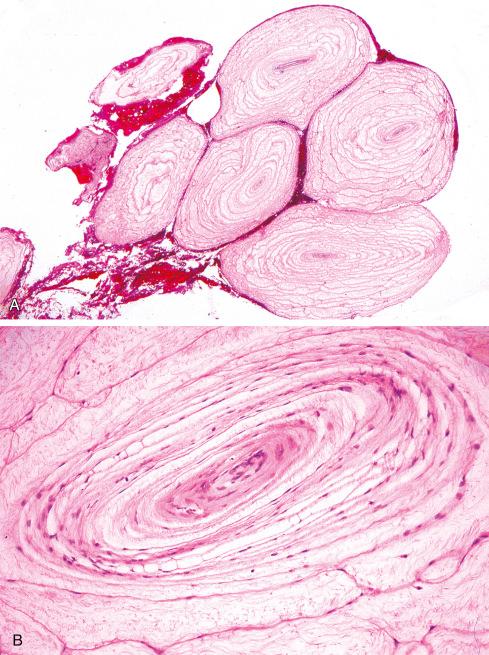
The solitary circumscribed neuroma, also known as “palisaded encapsulated neuroma,” can be conceptualized as a hyperplastic expansion of Schwann cells and axons of a cutaneous peripheral nerve. The term solitary circumscribed neuroma is now preferred for these tumors, since they may be neither palisaded nor encapsulated. Although slow to gain acceptance because of some similarity to the schwannoma, it has distinct clinical features. Solitary circumscribed neuromas develop as a small, asymptomatic nodule in the area of the face of adult patients. Rare cases on the distal extremities have been reported. Males and females are involved equally. Affected patients do not display manifestations of neurofibromatosis 1 or MEN-2b.
Histologically, one or more circumscribed or encapsulated nodules occupy the deep dermis and subcutaneous tissues ( Fig. 26.9 ). In some cases the nodules form clublike extensions into the subcutaneous tissue or may even have a plexiform architecture. They consist of a solid proliferation of Schwann cells and lack the variety of stromal changes (e.g., myxoid change, hyalinization) that may be encountered in schwannomas and neurofibromas ( Fig. 26.10 ). Although superficially these neuromas may resemble schwannomas, particularly if minor degrees of nuclear palisading are noted, they differ by the presence of axons, best demonstrated with silver stains or neurofilament protein immunohistochemistry (IHC), that traverse the lesion in close association with the Schwann cells. Schwannomas may contain axons, but they are typically located peripherally, immediately underneath the capsule.
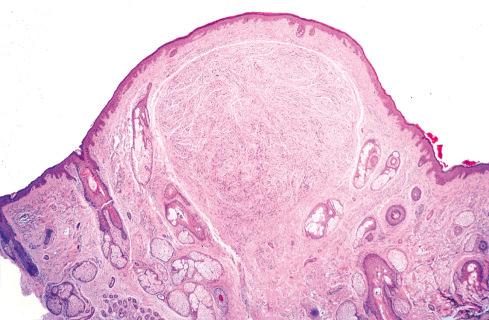
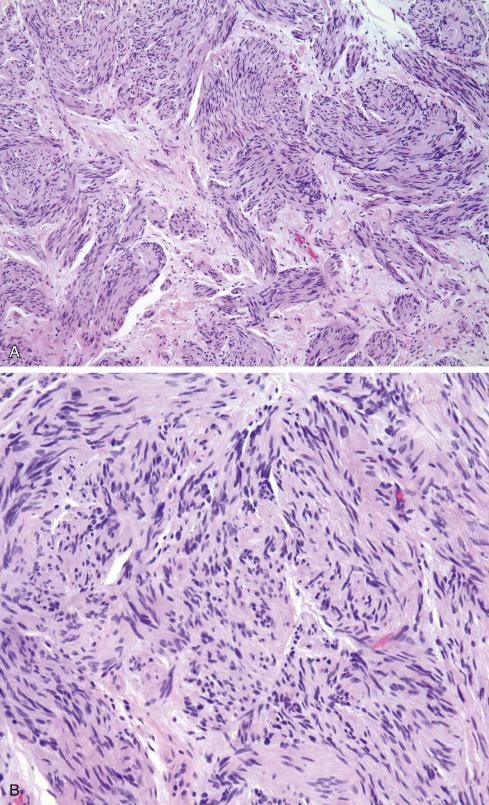
In most instances, simple excision of solitary circumscribed neuroma has proved curative. In contrast to a traumatic neuroma, these lesions are encapsulated, more uniform appearing, and unassociated with a damaged nerve.
Morton interdigital neuroma is not a true tumor but rather a fibrosing process of the plantar digital nerve that results in paroxysmal pain in the sole of the foot, usually between the heads of the third and fourth metatarsals and less often between the second and third. The pain typically commences with exercise, is alleviated by rest, and may radiate into the toes or leg. In some cases, a small area of point tenderness can be defined, although generally no mass can be palpated. Theories to explain this condition have included chronic trauma, ischemia, and bursitis. Evidence favors that Morton neuroma is a nerve entrapment syndrome caused by impingement on the plantar digital nerve by the deep transverse intermetatarsal ligament or by the adjacent metatarsal heads. Because women are affected more often than men, the wearing of ill-fitting high-heeled shoes has been incriminated in the pathogenesis of this condition. Lesions histologically similar to Morton neuroma are sometimes seen in relation to nerves in the hand, where they are undoubtedly related to chronic occupational or recreational injury.
At surgery, the characteristic lesion is a firm fusiform enlargement of the plantar digital nerve at its bifurcation point. In advanced cases, the nerve may be firmly attached to the adjacent bursa and soft tissue. Although grossly the lesion resembles a traumatic neuroma or neurofibroma, it is different histologically. Proliferative changes characterize traumatic neuromas, whereas degenerative changes are the hallmark of Morton neuroma. Edema, fibrosis, and demyelinization occur within the nerve ( Fig. 26.11A ). Hyalinization of endoneurial vessels is also present in some cases ( Fig. 26.11B ). Elastic fibers are diminished in the center of the lesions but are increased at its periphery, where they have a bilaminar appearance similar to the elastic fibers in an elastofibroma. As the lesion progresses, the fibrosis becomes marked and envelops the epineurium and perineurium concentrically and may even extend into the surrounding tissue. Although conservative treatment such as orthopedic footwear and corticosteroid injections are first-line measures, the most successful therapy is removal of the affected nerve segment.
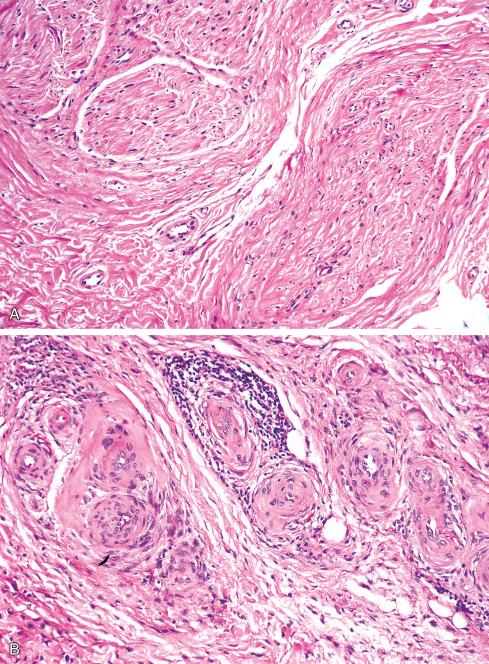
Rarely, ganglion cysts occur in intraneural locations. These lesions present as tender masses with pain or numbness in the distribution of the affected nerve. Most of these lesions are located in the external popliteal nerve at the head of the fibula, which suggests that a particular type of injury or irritation leads to their development. The nerve exhibits localized swelling that corresponds to myxoid change with secondary cyst formation. In some cases, however, the unlined cysts dominate the histologic picture and cause marked displacement of the nerve fascicles toward one side of the sheath ( Fig. 26.12 ). This lesion, like its soft tissue counterpart, represents a degenerative process rather than a neoplasm. The myxoid zones in these lesions have caused confusion with the so-called nerve sheath myxoma, a true neoplasm probably of Schwann cell origin, which is quite distinct from nerve sheath ganglion. Therapy of a nerve sheath ganglion cyst consists of local excision, although decompression is acceptable if the integrity of the nerve is threatened.
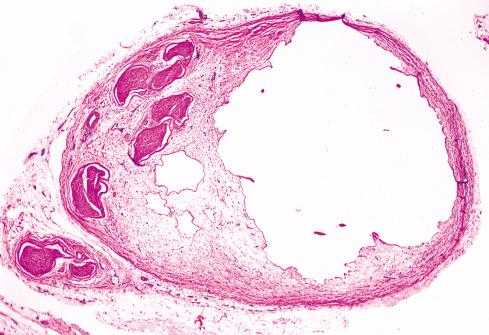
Tumors composed of skeletal muscle and neural elements are collectively referred to as Triton tumors in accord with an early hypothesis concerning their histogenesis (see Chapter 27 ). The best recognized of these mosaic tumors is the malignant peripheral nerve sheath tumor (MPNST) with rhabdomyoblastic differentiation (malignant Triton tumor), although combinations such as rhabdomyosarcoma with ganglion cells (ectomesenchymoma) also occur. Benign lesions composed of neural and skeletal muscle differentiation are rare and are represented principally by the neuromuscular choristoma and the neurofibroma with a rhabdomyomatous component.
Of the fewer than 50 cases from the literature, the majority occurred in young children as solitary masses involving large nerve trunks, particularly the brachial and sciatic. Tumors arising from the cranial nerves also occur, but usually present during adult life. The case described by O’Connell and Rosenberg presented as multiple lesions outside the nerve. Because of their strategic locations, neurologic symptoms are prominent. Magnetic resonance imaging (MRI) may be helpful in diagnosis because these lesions typically present as fusiform expansions of the involved nerve, with T1 and T2 signal intensities similar to normal skeletal muscle, minimal interposed adipose tissue, and absent gadolinium enhancement. Grossly, the lesions simulate a benign nerve sheath tumor. The tumors are multinodular masses subdivided by fibrous bands into smaller nodules or fascicles. Each fascicle is composed of highly differentiated skeletal muscle fibers that vary in size but are often larger than normal. Intimately associated with the skeletal muscle and sharing the same perimysial sheath are both small myelinated and nonmyelinated nerves ( Fig. 26.13 ). IHC studies for neural and muscle markers highlight the close juxtaposition of both components. Smooth muscle is rarely present.
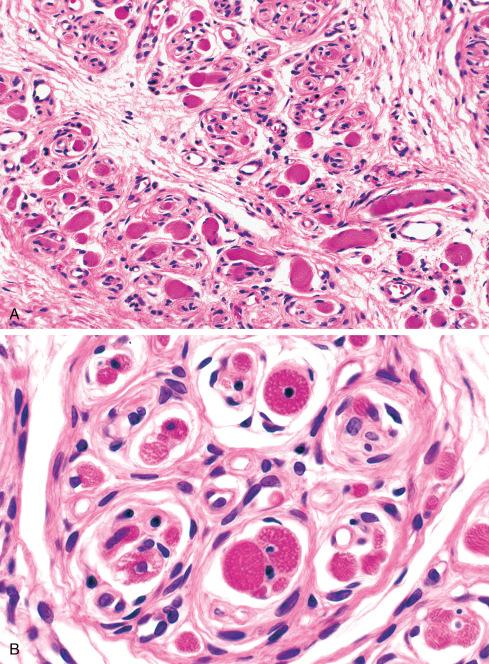
Several reports attest to the association between neuromuscular choristoma and deep fibromatosis. In some cases the lesions are noted simultaneously, whereas in others the fibromatosis supervenes months to years after the initial biopsy of the choristoma. In four of five cases studied by Carter et al., both the neuromuscular choristoma and the fibromatosis possessed mutations in CTNNB1 , with identical mutations in three patients. It was suggested that the unique monomelic distribution of neuromuscular choristomas pointed toward a postzygotic somatic event within an ectomesenchymal precursor, with CTNNB1 mutation and abnormal β-catenin signaling resulting in the abnormal combination of nerve and skeletal muscle that characterize these lesions. Biopsy appears to be the inciting factor in the development of fibromatoses in patients with neuromuscular choristoma, and it should not be performed in patients with radiographically typical lesions. A similar phenomenon may occur in another fibromatosis precursor, Gardner-associated fibroma.
Neurofibromas may assume one of three growth patterns: localized, diffuse, or plexiform. The localized form is seen most often as a superficial, solitary tumor in normal individuals. Diffuse and plexiform neurofibromas have a close association with neurofibromatosis 1 (NF1), the latter almost pathognomonic of the disease, as discussed later.
Localized neurofibromas occur most often as sporadic lesions in patients who do not have NF1. Their exact incidence is unknown because of the difficulty in excluding the diagnosis of NF1 in some patients, such as young persons, in whom the initial presentation of the disease may be a solitary neurofibroma, or patients who have no affected family members. Despite these problems, it appears that sporadic neurofibromas outnumber those occurring in NF1 by a considerable margin.
Localized sporadic neurofibromas, like their inherited counterparts, affect the genders equally. Most develop in persons between ages 20 and 30 years. Because most are superficial lesions of the dermis or subcutis, they are found evenly distributed over the body surface. They grow slowly as painless nodules that produce few symptoms. Grossly, they are glistening tan-white tumors that lack the secondary degenerative changes common to schwannomas. If they arise in major nerves, they expand the structure in a fusiform fashion, and normal nerves can be seen entering and exiting from the mass ( Fig. 26.14 ). If this lesion remains confined by the epineurium, it has a true capsule. More frequently, these tumors arise in small nerves and readily extend into soft tissue. These tumors appear circumscribed but not encapsulated.
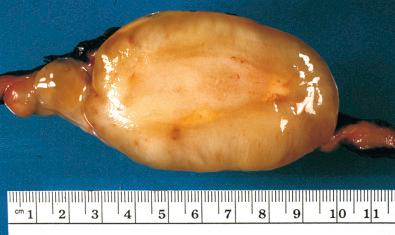
Histologically, neurofibromas vary, depending on their content of cells, stromal mucin, and collagen ( Figs. 26.15 to 26.18 ). In its most characteristic form, neurofibromas contain interlacing bundles of elongated cells with wavy, darkly stained nuclei. The cells are intimately associated with wirelike strands of collagen that have been likened to shredded carrots. Small to moderate amounts of mucoid material separate the cells and collagen. The stroma of the tumor is dotted with mast cells, lymphocytes, and rarely xanthoma cells. Less frequently, neurofibromas are highly cellular and consist of Schwann cells set in a uniform collagen matrix devoid of mucosubstances ( Fig. 26.16 ). The cells may be arranged in short fascicles, whorls, or even a storiform pattern. In certain respects, these cellular neurofibromas resemble Antoni A areas of a schwannoma. Unlike schwannomas, however, neurofibromas are not encapsulated and lack a clear partition into two zones. Moreover, small neurites can usually be demonstrated throughout these tumors. Least commonly, neurofibromas are highly myxoid and therefore often confused with myxomas ; this form of neurofibroma usually occurs on the extremities. These hypocellular neoplasms contain pools of acid mucopolysaccharide with widely spaced Schwann cells. In contrast to the cells of myxoma, neurofibroma cells usually have a greater degree of orientation. The vascularity is also more prominent, and with careful searching, features of specific differentiation (e.g., pseudomeissnerian bodies) may be found. Rare variations in neurofibromas are epithelioid change of the Schwann cells and skeletal muscle ( Fig. 26.19 ). Extraordinarily rare cases contain benign glands or rosettes. S-100 protein and SOX10 can be identified in these tumors but stain only a subset of cells, in keeping with the observation that neurofibromas contain a mixed population of cells (see Fig. 26.18 ).
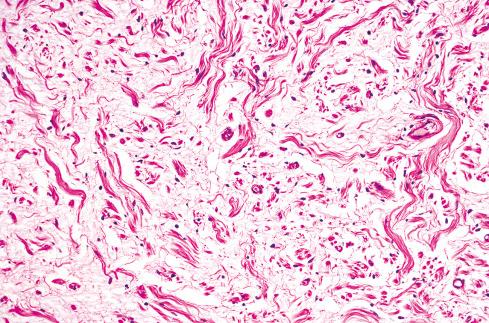
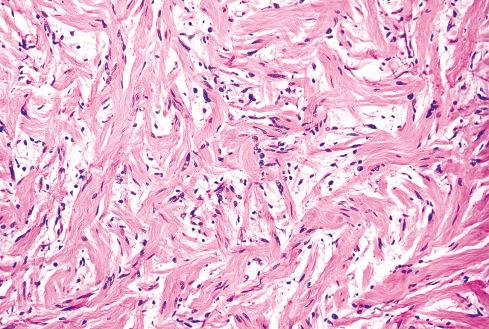
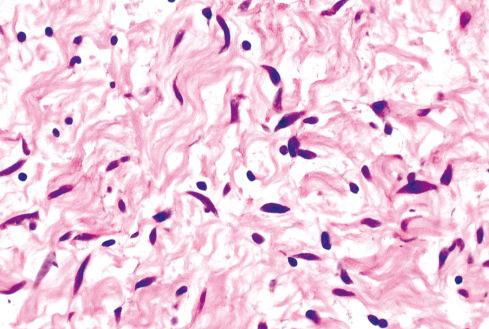
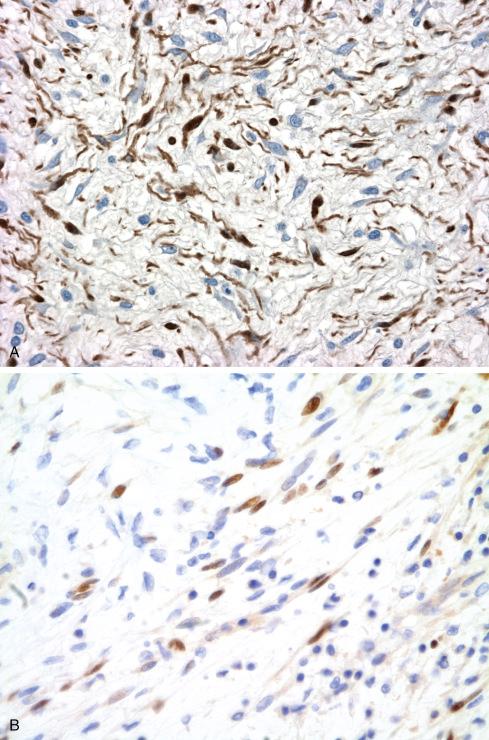
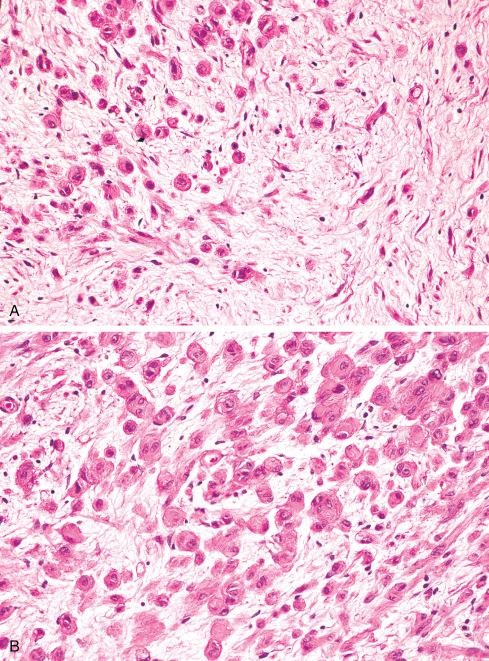
Although solitary neurofibromas are not associated with the same incidence of malignant change as their inherited counterparts, the exact risk is unknown. It is probably vanishingly small. Simple excision of these tumors is considered adequate therapy.
Neurofibromatosis, also termed von Recklinghausen disease for the German pathologist who described the disease in 1882, was formerly considered a single disease but is now known to be at least two clinically and genetically distinct diseases. The more common disease, formerly known as the “peripheral” form of neurofibromatosis, is designated neurofibromatosis 1 (NF1), whereas the less common disease, formerly known as the “central” form, is designated neurofibromatosis 2 (NF2) (bilateral vestibular schwannoma).
A common genetic disease, NF1 affects 1 in every 3500 individuals. It is inherited as an autosomal dominant trait with a high rate of penetrance. Because only half the patients with NF1 have affected family members, the disease in the remaining patients represents new mutations. The mutation rate, estimated at 10 −4 per gamete per generation, is among the highest for a dominantly inherited trait. About 80% of new mutations are of paternal origin.
NF1 is caused by deletions, insertions, stop mutations, amino acid substitutions, and splicing mutations in the NF1 gene, a tumor suppressor gene located in the pericentromeric region of chromosome 17. Spanning a distance of 300 kb and containing at least 60 exons, it is one of the largest human genes, an observation that likely explains its high mutation rate. It encodes an approximately 2800–amino acid protein known as neurofibromin , several isoforms of which are differentially expressed in tissues such as brain, neurons, and peripheral nerve. A small portion of neurofibromin possesses sequence homology to the RAS GTPase-activating protein (RAS-GAP) family of proteins that inactivate RAS. Loss of NF1 gene expression therefore results in increased RAS activity, cell proliferation, and tumorigenesis. Increased RAS-GTP results in increased Raf kinase–mediated signaling, which in turn activates a signaling cascade involving MEK kinase and the Erk1 and Erk 2 isoforms of MAPK, causing cell proliferation. Increased RAS-GTP also activates the mTOR pathway, which protects cells from apoptosis. Neurofibromin has other functions as well. For example, neurofibromin positively regulates cyclic AMP, which in turn modulates astrocytic growth and differentiation in the brain. Neurofibromas in patients with NF1 are composed chiefly of neurofibromin-deficient Schwann cells. Understanding these additional signaling pathways will likely begin to explain the protean manifestations of the disease.
Although, in principle, diagnosis of NF1 should be possible through genetic testing, the large size of the gene and the myriad of mutations have precluded this. Instead, a protein truncation assay to screen for stop mutations has been devised. Unfortunately, it detects only two-thirds of cases and does not predict severity of the disease. More recently, deep sequencing of all 60 NF1 exons, copy number analyses, and screening for intronic splicing site mutations have been reported to identify 95% of presumed NF1 mutations. Some commercial laboratories are also now performing complete sequencing of the entire NF1 gene; Longo et al., however, report that this approach has only been successful in 75% to 85% of candidate cases, for unclear reasons. Therefore the diagnosis of NF1 is still at least in part dependent on identification of the cardinal signs of the disease, two or more of which must be present to establish the diagnosis ( Box 26.1 ).
NF1 is diagnosed in an individual with two or more of the following signs or factors:
Six or more café au lait macules: >5 mm in greatest diameter in prepubertal individuals; >15 mm in greatest diameter in postpubertal individuals
Two or more neurofibromas of any type or one plexiform neurofibroma
Freckling in the axillary or inguinal region
Optic glioma
Two or more Lisch nodules (iris hamartomas)
A distinctive osseous lesion such as sphenoid dysplasia or thinning of long bone cortex with or without pseudoarthrosis
First-degree relative (parent, sibling, offspring) with NF1 by the above criteria
The severity of the disease varies widely from patient to patient and from family to family. Because of the complexity of the disease and size of the gene, it has been difficult to perform precise genotypic-phenotypic correlations. Only in patients with extremely severe forms of the disease who harbor large deletions have such correlations been possible. It is therefore likely that genetic modifiers outside the NF1 locus play a role in disease symptoms. Complete gene deletions are associated with severe symptoms of NF1, a large number of neurofibromas, and significantly higher lifetime risk for MPNST, whereas mutations at the 3’ end of the gene correlate with familial spinal neurofibromatosis. Segmental forms of neurofibromatosis may be explained by somatic mosaicism.
In the typical patient, NF1 becomes evident within the first few years of life when café au lait spots develop. These pigmented macular lesions resemble freckles, especially during the early stage when they are small. Typically, they become much larger and darker with age and occur mainly on unexposed surfaces of the body ( Fig. 26.20 ). One of the most characteristic locations for café au lait spots is the axilla ( axillary freckle sign ). Pathologically, the spots are characterized by an increase in melanin pigment in the basal layer of the epidermis. In adults, only lesions larger than 1.5 cm are considered café au lait spots for purposes of diagnosis. Because the number of café au lait spots increases with age, and more than 90% of patients with neurofibromatosis have these lesions, their number serves as a useful guideline when making the diagnosis. Not only do these lesions herald the onset of the disease, but in older patients they often give some indication as to the form and severity of the disease. For instance, patients with few café au lait spots tend to have either (1) late onset of palpable neurofibromas, (2) localization of neurofibromas to one segment of the body, or (3) NF2.
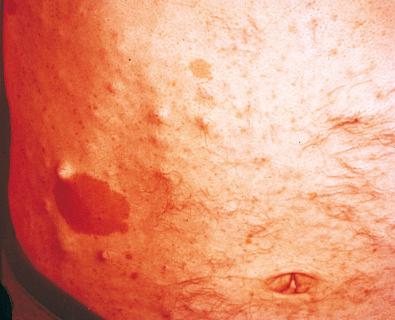
Neurofibromas, the hallmark of the disease, make their appearance during childhood or adolescence after the café au lait spots. The time course varies greatly; some tumors emerge at birth, and others appear during late adult life ( Fig. 26.21 ). They may be found in virtually any location and in rare cases may be restricted to one area of the body ( segmental neurofibromatosis ). Unusual symptoms have been related to the presence of these tumors in various organs such as the GI tract. The tumors are usually slowly growing lesions. Acceleration of their growth rate has been noted during pregnancy and at puberty. A sudden increase in the size of one lesion should always suggest malignant change.
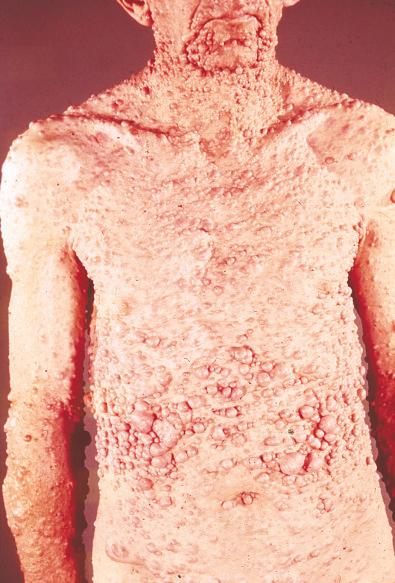
In addition to peripheral neurofibromas, patients with NF1 also develop central nervous system (CNS) tumors, including optic nerve glioma, astrocytoma, and a variety of heterotopias. Vestibular schwannoma, the hallmark of NF2, is virtually never encountered in NF1. Unusual bright objects are detected by T2-weighted MRI in the brain in more than 60% of patients with NF1 and are thought to provide some indication of the degree of cognitive dysfunction.
Pigmented hamartomas of the iris ( Lisch nodules ) may also be found. These asymptomatic lesions are not present in normal individuals or in those with NF2 ( Figs. 26.22 and 26.23 ). Although Lisch nodules cannot be correlated with other specific manifestations of NF1, they are helpful for establishing the diagnosis.
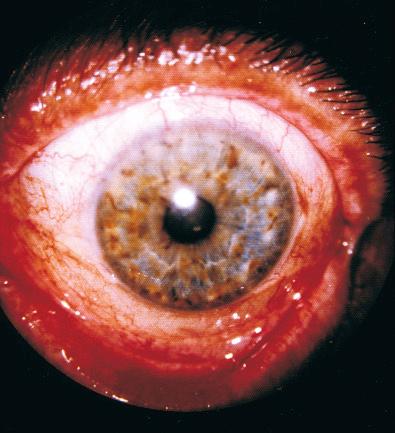
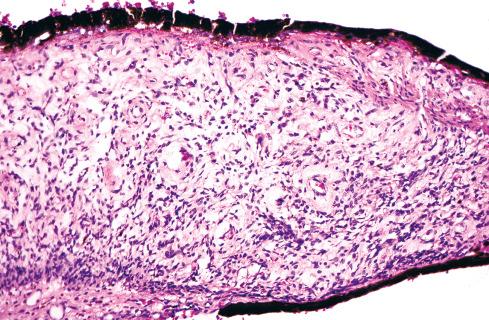
Skeletal abnormalities occur in almost 40% of patients with NF1. They include erosive defects secondary to impingement by soft tissue tumors and primary defects, such as scalloping of the vertebra, congenital bowing of long bones with pseudoarthrosis, unilateral orbital malformations, and cystic osteolytic lesions. The intraosseous cystic lesions were previously believed to be skeletal neurofibromas, but most of these lesions have the histologic appearance of nonossifying fibroma or fibrous cortical defect, characterized by fascicles of fibroblasts arranged in short, intersecting fascicles (sometimes in a storiform pattern) and punctuated with occasional giant cells.
Vascular abnormalities, specifically vascular stenoses, secondary to proliferation of intimal cells, are a significant cause of premature death from renovascular hypertension or stroke. Gynecomastia-like changes (pseudogynecomastia) consisting of stromal hyalinization with nerve fibers and fibroblasts, some of which are multinucleated, have been reported in young males with the disease. In addition to these well-recognized signs and symptoms, NF1 is associated with diverse symptoms not clearly referable to the presence of tumors. They include disorders of growth, sexual maturation, and cognition and abnormalities of the lung. Patients with NF1 are also prone to develop nonneural tumors, notably pheochromocytoma, myelogenous leukemia, and multifocal gastrointestinal stromal tumor (GIST).
In addition to classic NF1, there appear to be variant forms in which the features are atypical or incomplete. They include (1) segmental NF manifesting as neurofibromas in a segmental distribution caused by somatic mosaicism of NF1 mutations, (2) gastrointestinal NF, (3) familial spinal NF, and (4) familial café au lait spots.
Several types of neurofibroma occur with NF1 and are distinguished on the basis of their gross and microscopic appearance.
Localized neurofibroma is the most common type encountered, but it is histologically the least characteristic because identical lesions also occur on a sporadic basis. These tumors are typically located in the dermis and subcutis but may be located in deep soft tissue as well. The tumors are larger than solitary neurofibromas. Large pendulous tumors of the skin were referred to as fibroma molluscum in the early literature.
Histologically, these tumors are no different from solitary neurofibromas and embrace a spectrum from highly cellular to highly myxoid tumors. When malignant transformation occurs, it is usually in deeply situated lesions (see later).
Become a Clinical Tree membership for Full access and enjoy Unlimited articles
If you are a member. Log in here